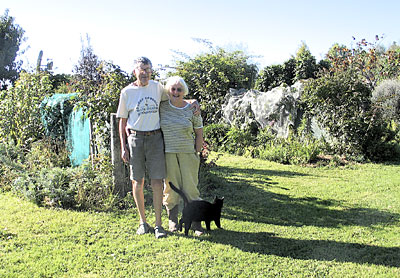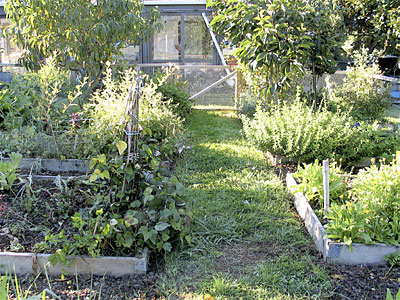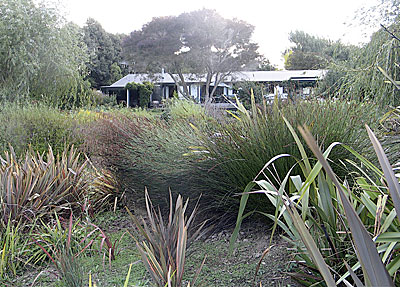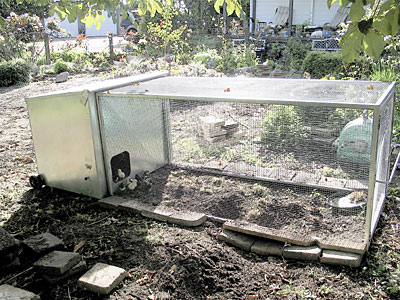 |
| Heather and Francis Young grow an abundance of food on their 3 acres in the Bay of Plenty district in New Zealand. Laura Sayre photo. |
 |
| Part of the herb and vegetable garden is in raised beds. Laura Sayre photo. |
 |
| A low-maintenance part of the Youngs’ landscape. Laura Sayre photo. |
Life on the far side of world is unusual in some ways, familiar in others …
by Laura Sayre
Heather and Francis Young are two New Zealanders by birth who moved to Illinois for three years in 1969, when they were a young married couple with two small children, and ended up staying for 30 years. Francis, a chemical engineer, taught for many years at the University of Illinois in Champaign-Urbana. Heather, with a Master’s degree in Extension Education, is an agricultural educator who taught college-level botany and became active in the Illinois Master Gardeners program. But when it came time to think about retirement, the Youngs decided to move home. Now, on just 3 acres in the North Island’s Bay of Plenty district, near the town of Katikati, they’re demonstrating what it means to live the good life, Kiwi-style.
The Youngs, long-term friends of MOFGA stalwart Beedy Parker and her late husband, Dick, met some MOF&G readers while visiting the Parkers at their Camden, Maine, home last summer. In the spirit of cross-hemispheric exchange, my husband, Michael (another New Zealander), and I visited the Youngs during a recent trip to see Michael’s family and other Kiwi connections. Combined with reporting on organic farming from previous visits to New Zealand, our three days with the Youngs offered valuable insights into the joys and challenges of homesteading in a land where “north-facing exposure” is what you’re after. (That’s where the sun is!)
A View of the Sea
Heather and Francis’ property lies at the tip of a small peninsula at the western edge of the Bay of Plenty. A long, low island protects them from the open sea; at low tide, it’s possible to walk or horseback-ride across to the island, which belongs mostly to the local Maori, New Zealand’s indigenous peoples. The Youngs purchased the property in the depths of the New Zealand winter, figuring that if it looked appealing in August, it would look good year round.
Winters here are cold and damp but have no snow and only occasional light frosts. Heather and Francis admit that their primary motivation for returning to New Zealand was the climate. “We wanted to move somewhere where we could garden 12 months a year instead of six,” explains Francis. In Katikati, “we can grow plants from all over the world – North America, South America, Africa, Australia, Britain.” And they do: proteas from South Africa, Australian eucalyptus, native cabbage trees and flaxes, useful and ornamental garden species from Europe and America – all thrive here in lush abundance.
Make no mistake, however – the garden’s present bounty is the product of eight years of hard work. “When we bought the property, this was all just paddock,” Francis says, gesturing across the garden to the estuary beyond. The low-lying land was protected from the bay by a dike and bordered on three sides by a canal; the house was too small to accommodate guests and in need of updating. Making the land accessible and suitable for gardening involved diverting some of the canal underground (Francis’ engineering skills came in handy here), installing a few small bridges and digging a couple of ponds. The Youngs also expanded the house, adding decks on the bay side and enlarging the kitchen to facilitate plenty of home cooking and food preservation.
A Gardener’s Paradise?
Countless hours of digging, planting, weeding, mulching and composting later, the Youngs are demonstrating how possible it is to be largely self-sufficient in food in New Zealand – and to have fun doing it. “We can grow fruit year round,” says Francis. “We just eat whatever’s in season.” Depending on the time of year, that includes oranges, lemons, limes, grapefruit, apples, pears, nectarines, quince, raspberries, grapes, plums, peaches, persimmons, avocadoes and feijoas (a small tree fruit originally from South America and now grown widely in New Zealand). They also have a veggie garden where they grow such staples as tomatoes, salad greens, cole crops, root crops and herbs. The Bay of Plenty climate isn’t hot enough to grow crops like melons and eggplant successfully, but that doesn’t stop the Youngs from trying.
Like many rural New Zealanders, the Youngs rely on rooftop rain collection for all their water, including water for drinking and washing in the house. They normally get about an inch of rain a week throughout the growing season, so they don’t have to irrigate the gardens, although last summer (December-February) was unusually dry and they came close.
 |
| A portable chicken coop is part of the Youngs’ landscape. Laura Sayre photo. |
In addition to the climate, New Zealand growers enjoy a nearly total absence of many major pests. The Youngs say they were most happy to be rid of Colorado potato beetles, Japanese beetles, flea beetles, cucumber beetles, squash vine borers, corn earworms and cutworms. They do have aphids, slugs and snails – and pukekoes, a native bird about the size of a large, lean chicken that can be very destructive, pulling up young seedlings and helping itself to ripening fruit. Pukekoes are clever, too, happily working their way through bird netting, so beating them to the fruit is an ongoing battle. But it’s hard to feel too sorry for New Zealanders on the pest front.
Chickens are a relatively recent addition to the homestead. A “Cadillac Coop” – a small chicken tractor made of galvanized sheet metal by a Hamilton, NZ, company – shelters “Super Mum” and her latest clutch of 11 chicks. Other chickens from earlier hatches have the run of the garden, with the veggie garden protected by a low fence. After experimenting with a few breeds, Heather prefers Dorking-Cross hens as being relatively productive, sturdy and not too inquisitive; some of the smaller, more active breeds were inclined to enter the house through any open door or window, with predictable consequences.
Challenges
Not everything has been an unmitigated success. A few plantings, such as willows, proved too weedy; canna lilies volunteer vigorously here, with no winter freeze to restrain them. One pond, which Francis lined with cement, goes dry every year. But living and learning is part of the joy of gardening, where there are always new projects and new surprises.
Also marring this idyllic landscape somewhat are two nearby conventional kiwifruit orchards, with attendant spraying of pesticides and growth regulators. The orchards are surrounded by high, dense cypress hedges (kiwifruit are highly susceptible to wind damage), and the neighbors notify the Youngs when they’re planning to spray, so they can arrange to be elsewhere; still, it’s a concern. In the 1950s, this was all beef and dairy country, but since the introduction of the Chinese gooseberry in the 1980s, the Bay of Plenty has been New Zealand’s leading kiwifruit district. Around 5% of NZ kiwifruit production is organic (including a couple of growers on the Young’s peninsula), and chemical use has declined in non-organic kiwifruit cultivation, but you’re definitely aware here that you’re in the presence of serious production agriculture. Wine grapes, avocadoes, olives and other fruits are also grown in the region, along with continued dairying and stock rearing.
For the most part, though, production agriculture – organic and non-organic – and homesteading co-exist peacefully in the Bay of Plenty. Visitors to New Zealand immediately notice the respect granted to farming within the culture as a whole, recognition of its importance to the national economy. Kiwis also openly value the rural way of life. Beginning in the 1980s, a change in land-use regulations enabled large-scale landowners to sell 10-acre sections, leading to the popular, so-called “lifestyle blocks” among New Zealanders wanting to get back to the land. For the most part, as the name implies, these properties were about lifestyle, not farm enterprises. The elimination of farm subsidies around the same time, however, forced all farmers here to be more attentive to market forces, seeking various strategies to make their farms profitable, sustainable and efficient, be it through agri-tourism, value-added enterprises or catering to overseas demand for quality meats, fruits and dairy products. All these versions of agricultural intensification have made it more feasible to make a living on a smaller number of acres, blurring the line between lifestyle block-owners and “real” farmers.
Still, one possible downside of New Zealand’s benignant climate and strong conventional ag sector is that small-scale organic market gardeners can have trouble finding an adequate local customer base. Farmers’ markets are becoming more common, but they’re still generally small, and most people shop for vegetables at supermarkets or at local produce stands (which sell imported as well as NZ-grown produce); or they grow their own. Lynda Hallinan, editor of New Zealand Gardener magazine, claims to have spent all of 2007 living off the bounty of her small garden in Auckland (population 1.3 million), with only NZ$10 a week for supplemental food purchases, swapping extra produce for meat from her local butcher. New Zealand Gardener is not an organic publication, but Heather is impressed with the message Hallinan is giving her readers: Grow something to eat, even if it’s just a few herbs.
That message seems to be resonating. As in the United States, rising prices and general economic insecurity may be spurring a back-to-basics impulse among citizens. Everywhere we went, people were lamenting sharp increases in the prices of milk, butter and cheese over the past year, as New Zealand’s dairy farmers enjoy record-high global demand. Another organic gardener I spoke with, in nearby Paeroa, noted that attendance at a local series of talks on biodynamic farming and gardening had increased markedly over previous years. Organic agriculture in New Zealand still has a long way to go, but the country may be on the cusp of another wave of environmental consciousness.
The Katikati Community
For the Youngs, nurturing that environmentalist spirit in their local community is as important as nurturing their own garden. Heather is president of the Katikati Herb Society and editor of herbnews, the quarterly publication of the Herb Federation of New Zealand (herbs.org.nz), of which the Katikati society is a chapter. (Francis is treasurer of HFNZ). “Most of our members are primarily interested in using medicinal herbs,” says Heather, but the group is trying to encourage production by hosting gardening workshops and other events. Heather and her associates undertake outreach efforts as well, maintaining a potager garden next to the local bookstore and another at nearby Te Puna Quarry Park, a former quarry being restored to gardens, walking trails and native bush with the help of a dedicated band of volunteers, Francis among them.
The vibrant and diverse local community seems to have a continuous array of gatherings designed to foster discussion and encourage more thoughtful, informed, sustainable living. The weekend my husband and I passed through, an event called Sustain a Day was being held at Te Puna Park, where participants could attend presentations on composting, worm farming, weed identification, flower arranging, and protecting native butterflies, among other topics. The local environmental council sponsored a simultaneous event called Funky Junk, in which kids and parents competed for awards for the best creation made using such throwaway materials as food packaging and old computer equipment. Meanwhile, in honor of National Herb Week (March 9-16), the Katikati Herb Society hosted Herb Fest, featuring snacks using herb-centric recipes, vendors selling potted herbs, and other activities.
Among those displaying their wares at Herb Fest were local organic producers Noeleen and Brian Lamb. In 2000, Lamb Organics (www.regenerate.co.nz) became the first certified organic skincare products company in New Zealand, making shampoos, soaps, lotions and other items from its own lavender, geranium, echinacea, gingko, olive, avocado and other plantings. They also sell certified organic avocado oil for kitchen use. Other local growers are raising organic macadamia nuts, making farmstead cheeses, rescuing heritage apple varieties and developing herbal remedies.
Thinking of Going?
For North Americans fantasizing about a future Down Under, remember that the Youngs re-emigrated at a favorable moment. In 2000, one U.S. dollar could buy almost two New Zealand dollars; this fall, the greenback was worth only about NZ$1.50. Property values in New Zealand have also risen sharply over the past decade, although they show signs of moderating. And interest rates around 8% make it difficult for first-time property buyers to afford mortgages.
On the upside, New Zealand’s latest jobs outlook reported shortages in a number of professions, including doctors, nurses, teachers, IT specialists – and horticultural farm managers. Temporary work permits for overseas visitors interested in seasonal farm labor were recently tightened, but those wanting to taste New Zealand’s rural life can also try WWOOFing (World Wide Opportunities on Organic Farms; www.wwoof.co.nz). New Zealanders by and large are friendly, hospitable, down-to-earth people who know how to work and how to enjoy life. The Youngs’ gardening retirement in Katikati is ample proof of that.
Here are two recipes that we brought back from New Zealand.
14-Day Slaw
1/2 c. cider vinegar
1/3 c. olive oil
1/2 c. white sugar or honey
1 tsp. celery salt
1 tsp. whole dry mustard seed
1/4
1/2 tsp. turmeric
1 tsp. salt
Stir together, bring to a boil to dissolve the sugar, then set aside to cool.
1 medium cabbage, shredded
2 carrots, grated
1 red beet, grated
1 onion, finely chopped
Combine with vinegar mixture in a glass (not plastic) bowl. Store covered in fridge for at least 12 hours before serving. Terrific as a side dish, or as a salad served with hard-boiled eggs.
Cheese, Onion and Herb Muffins
In addition to deliciously not-too-sweet blueberry muffins, date scones and other treats, most cafés in New Zealand offer “savory muffins” featuring ingredients such as cheese, tomatoes, sweet corn, broccoli, olives or ham. This recipe is adapted from Marvellous Muffins by Alison Holst (Dunedin: Hyndman Publishing, 1994).
1 c. flour
2 tsp. baking powder
1/2 tsp. salt
1 tsp. sugar
1/8 tsp. cayenne pepper
1 spring onion or small red onion, chopped fine
1/2 c. chopped parsley
1 Tbsp. chopped rosemary or other fresh herbs
1 c. grated cheddar or other cheese
1 egg
1/2 c. + 2 Tbsp. milk
In a large bowl, mix the first nine ingredients. In another bowl, beat the egg and milk. Stir the wet into the dry ingredients until just combined. Spoon into a standard muffin tin and bake at 395°F for 15-18 minutes. Makes 8-10 muffins.
